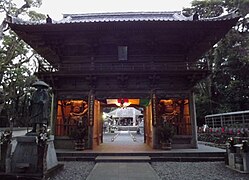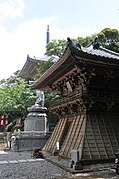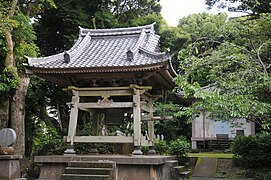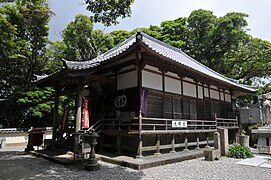Hotsumisaki-ji
The Hotsumisaki-ji ( Japanese 最 御 崎 寺 ), also called Higashi-dera (東 寺), with the Go Murotozan (室 戸 山) and Myōjōin (明星 院), located high on the Hotsumi Cape of Shikoku , which is part of the city of Muroto ( Kōchi Prefecture ) is a temple belonging to Shingon Buddhism . In the traditional count, it is the 24th temple on the Shikoku pilgrimage route .
history
The temple is said to have originally been on the Shiūjizan (四十 寺 山) until it was moved here during the Kantoku era (1044-1046). According to records, the temple burned down in 1202 and was also ravaged by fires thereafter. During the Muromachi period , the temple enjoyed the support of the Ashikaga , in the Edo period that of the Yamanouchi , who ruled the province of Tosa .
At the beginning of the Meiji period , the temple fell victim to the separation of Shintoism and Buddhism, but was later rebuilt. The main cult figure is Kokūzō Bosatsu (虚空 蔵 菩薩), which priest Kukai had carved for the temple.
investment
You enter the temple from the south through the temple gate, which is designed here as a Niō tower gate (仁王 門, Niōmon; 1), i.e. as a gate, with the temple guards to the right and left of the passage. On the right is the old bell tower (旧 鐘楼, Kyū Shōrō; 2), then on the left is the hall dedicated to the temple's founder, the Daishidō (大師 堂; 3). In front of this hall there is a "bell stone" (鐘 石, Kaneishi), which emits a bell sound when it is hit. On the right side is the pagoda, which here - as usual in Shingon - is designed as a treasure pagoda (多 宝塔, Tahōtō; 4). The main hall of the temple follows ahead (本 堂, Hondō; 5).
If you pass the main hall on the left side, you have the new bell tower on the right (新 鐘楼, Shin Shōrō; 6). Then there are pavilions on the right, of which the first is dedicated to Prince Shōtoku (聖 徳 堂; 7), and the second to the Goma ceremony (護 摩 堂; 7).
In the north of the complex is the large guest house for pilgrims (Q).
Treasures
The temple has numerous treasures, of which the following are classified as Important Cultural Property of Japan :
- Seated Yakushi Nyorai (the healing Buddha) - (木造 薬 師 如 来 坐像, Mokuzō Yakushi nyorai zazō), composed of wood, from the Fujiwara period, i.e. from the late Heian period . The sculpture is 85.7 cm high.
- Buddha's companion Gekkō (月光) also comes from the Fujiwara period. She is 102 cm high, her head is a little too big in relation to her body.
- The Kannon in the semi-lotus position with a raised leg (如意輪 観 音 半 跏 像, Nyoirin Kannon hankazō) is 53.2 cm high. Since it is made of marble - which never happened in Japan - it must have come over from the mainland.
- The red lacquered bowl (漆 塗 台 盤, Urushinuri daiban) has three feet and is therefore also called the "three-legged bowl" (三 足 丸 盆, Mitsuashi marubon). She received the temple as a gift from Hiwasa Hachimangū ( Tokushima Prefecture ) in 1379 . Its counterpart is painted black.
photos
literature
- Kōchi-ken kotogakko kyoiku kenkyukai rekishi bukai (Ed.): Hotsumisaki-ji . In: Kōchi-ken no rekishi sampo. Yamakawa Shuppan, 2006. ISBN 978-4-634-24639-3 . Pages 208 to 209.
- Oguri, Doei: Kukai. Shikoku hachijuhachi kosho no arukikata. Chukei no Bunko, 2011. ISBN 978-4-8061-4067-2 .
Web links
Coordinates: 33 ° 14 ′ 56.4 " N , 134 ° 10 ′ 32.7" E
← Previous Temple: Yakuō-ji | Hotsumisaki-ji | Next temple: Shinshō-ji →







